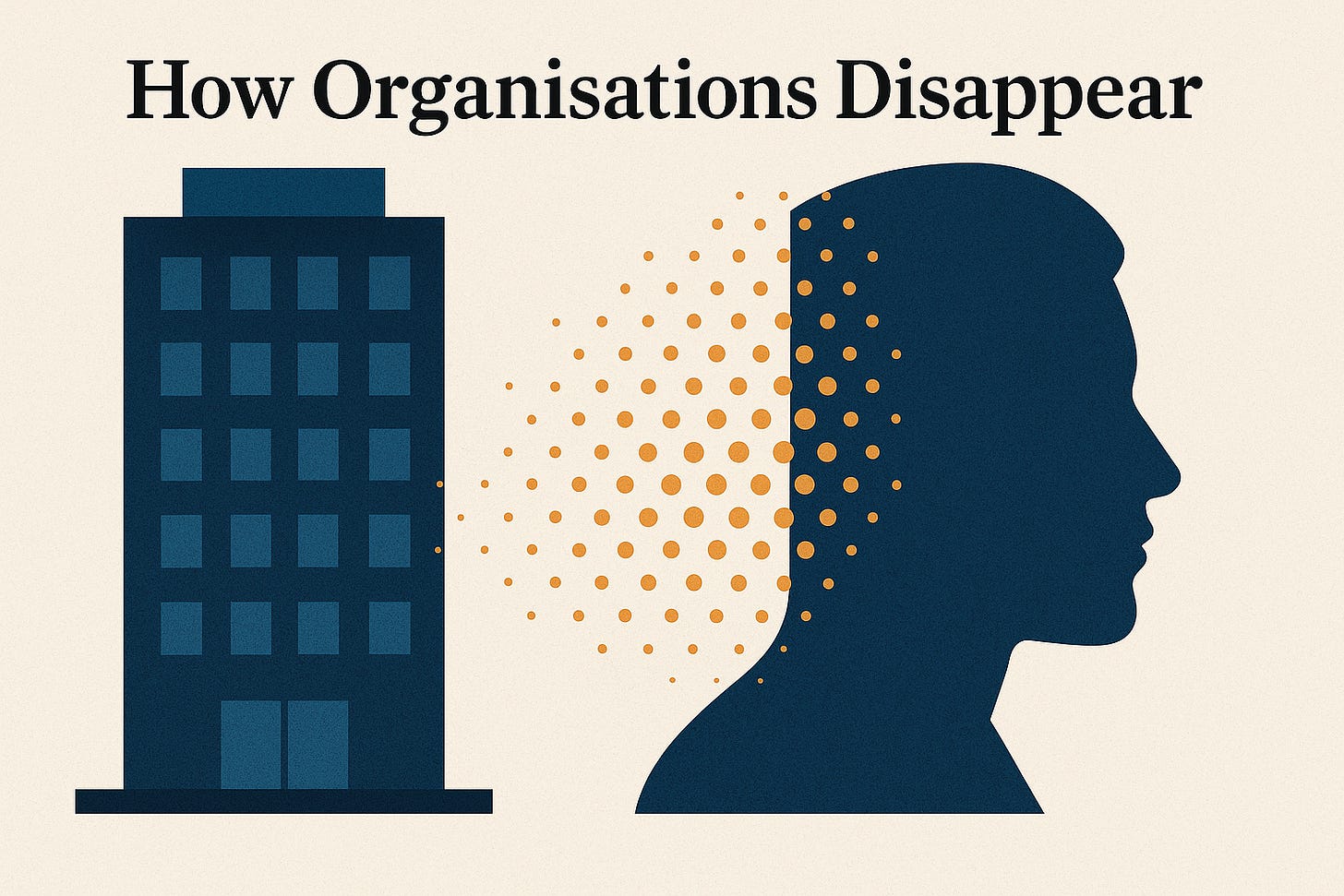How Organisations Disappear
Explore how organisations are dissolving into networks of individuals, code, and contracts—and what replaces the company as the core unit of coordination in digital work.
For most of the last century, the company was the defining institution of modern life. It provided not just employment but identity, structure, and rhythm. To “work for” someone meant belonging to something: a legal entity with a logo, an office, a hierarchy, and, ideally, a pension plan. The organisation was not just a means of production; it was a container for trust, coordination, and collective purpose.
The 21st-century economy has been slowly unbundling the functions once monopolised by companies. Accounting is handled by Stripe, HR by Deel, project management by Notion, design by Figma, execution by freelancers, and increasingly, strategy by AI. A one-person company today can do what once required departments, managers, and payrolls. The boundaries that once defined an organisation - legal, physical, managerial - are melting into digital infrastructure.
This shift is not limited to individuals. Entire collectives now operate without corporate form. DAOs (decentralised autonomous organisations) coordinate funding and execution through smart contracts. Open-source communities build billion-dollar ecosystems without central ownership. Networks like Gitcoin and Cabin create shared economies without shared offices. Even traditional companies are thinning out, outsourcing functions to contractors and algorithms while retaining only a core of brand and strategy. The organisation is less a fortress than a network of a constellation of temporary alliances held together by APIs and incentives.
Efficiency is undeniable. The barriers to building something have collapsed. The modern entrepreneur can found, fund, and scale an operation from a laptop, assembling global teams with a few clicks. But the cost of this freedom is subtle. What happens to culture when belonging becomes transactional? What happens to accountability when no one is technically employed? When coordination is distributed, does responsibility also diffuse?
We are not witnessing the death of the company, but its evaporation. The functions remain, but the container is fading. The question, then, is not whether organisations will survive, but in what form they will persist. As work becomes fluid, modular, and software-defined, the company as we know it begins to dissolve into the very infrastructure that once served it.
In this issue of Brewed for Work, we examine the quiet dissolution of the traditional organisation. As hierarchies give way to networks and code replaces management, the company as we know it is evaporating into digital infrastructure. From solopreneurs powered by AI to DAOs governed by smart contracts, we explore how coordination, culture, and accountability survive when the institution of the firm fades—and what might replace it in a post-organisational world.
More posts from this series:
Today’s Issue at a Glance:
From Hierarchies to Networks
The Rise of the Solopreneur and the Micro-Enterprise
DAOs and Decentralised Coordination
The Culture Collapse Problem
Post-Organisation Work — The Future of Coordination
So grab your favourite mug, and let's get brewing!
Welcome to Brewed for Work, 🔒subscribers-only🔒 offering by The Percolator dedicated to professional growth and upskilling. Each week we share essays, insights and resources to aid you in your work-life.
🚀
Now, you can Upgrade your Subscription for Free when you Invite your Friends to Subscribe to The Percolator
The organisation has long been the default unit of economic coordination. From the East India Company to General Electric, from Ford’s assembly lines to Google’s campuses, the corporation has been the mechanism through which people, capital, and ideas were brought together at scale.
It solved a fundamental problem: how to coordinate effort efficiently in a world where communication, contracts, and trust were expensive. Hierarchies emerged because they worked. Managers oversaw production, accountants tracked costs, and employees traded autonomy for stability. The corporation was not just an engine of profit, it was a structure of coherence.
But coherence now comes cheaper. Digital infrastructure has eaten much of what organisations were built to manage. Payment systems, cloud software, global contractor platforms, and AI tools have dramatically reduced the need for centralised administration. Tasks that once required departments can now be automated, outsourced, or self-managed through software. The functions that justified the company, finance, HR, coordination, even strategy etc. are increasingly performed by platforms and code.
The result is a slow-motion unbundling. The corporation, once vertically integrated, is being flattened into networks of individuals, tools, and temporary collaborations. Freelancers form ad hoc teams across time zones. DAOs distribute governance through blockchain protocols. Solopreneurs use AI to simulate entire departments. Even large companies operate more like ecosystems than monoliths, orchestrating external contractors, automation systems, and independent contributors. The firm is dissolving into its functions, those functions into software, and that software into infrastructure.
As hierarchy fades, coordination migrates to platforms; as employment fragments, trust migrates to brand and reputation; as culture thins, identity migrates to networks and digital communities. The organisation does not vanish but diffuses. The challenge is not whether work can exist without companies, but whether companies can exist without walls, ownership, or permanence.
This transformation raises deeper questions. What replaces the sense of belonging once offered by organisations? How is accountability enforced when no one reports to anyone? Can culture emerge without shared physical or legal boundaries? The tools of coordination have evolved faster than the social contracts that underpin them.
We are entering a post-organisational era; one where the company no longer acts as the default infrastructure of work. Its functions persist, but its form dissolves. What comes next may not look like a firm at all, but something lighter, looser, and profoundly different.
🏅
Keep reading with a 7-day free trial
Subscribe to The Percolator to keep reading this post and get 7 days of free access to the full post archives.






